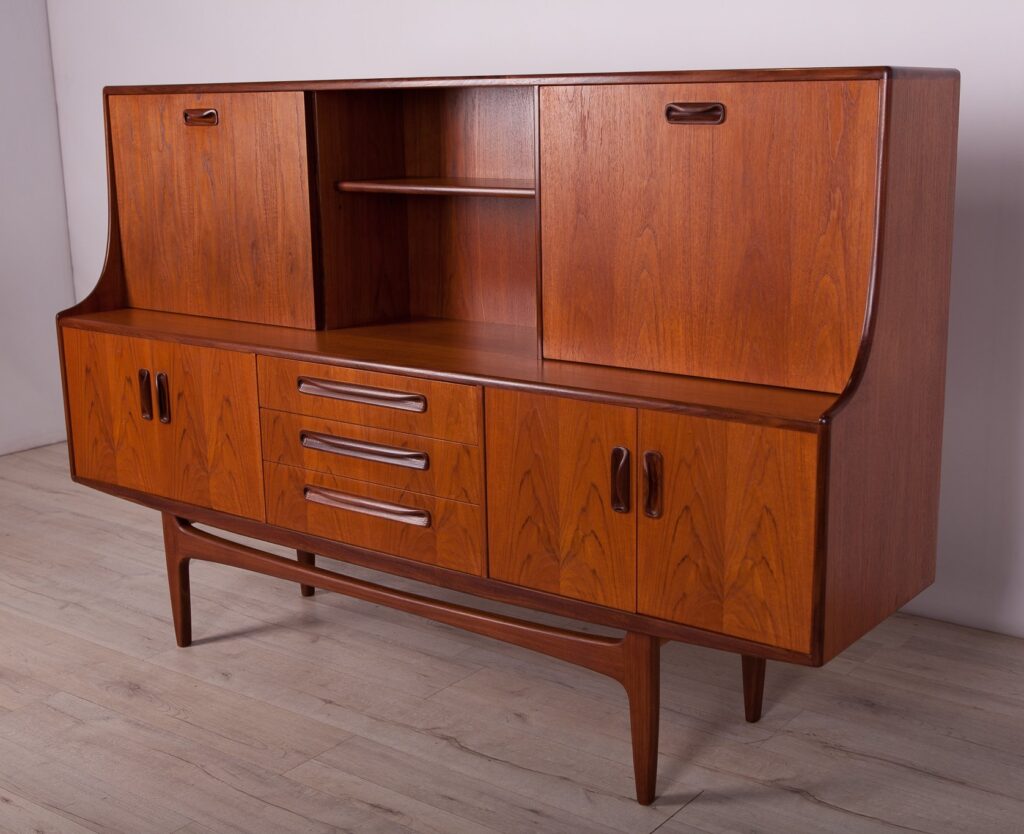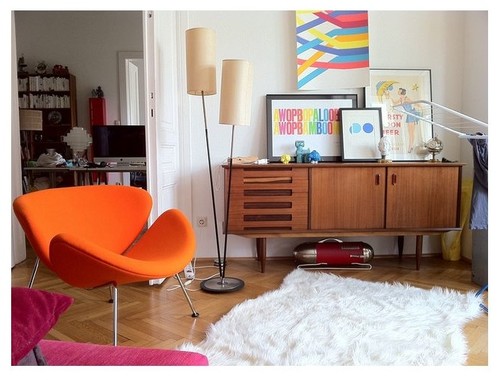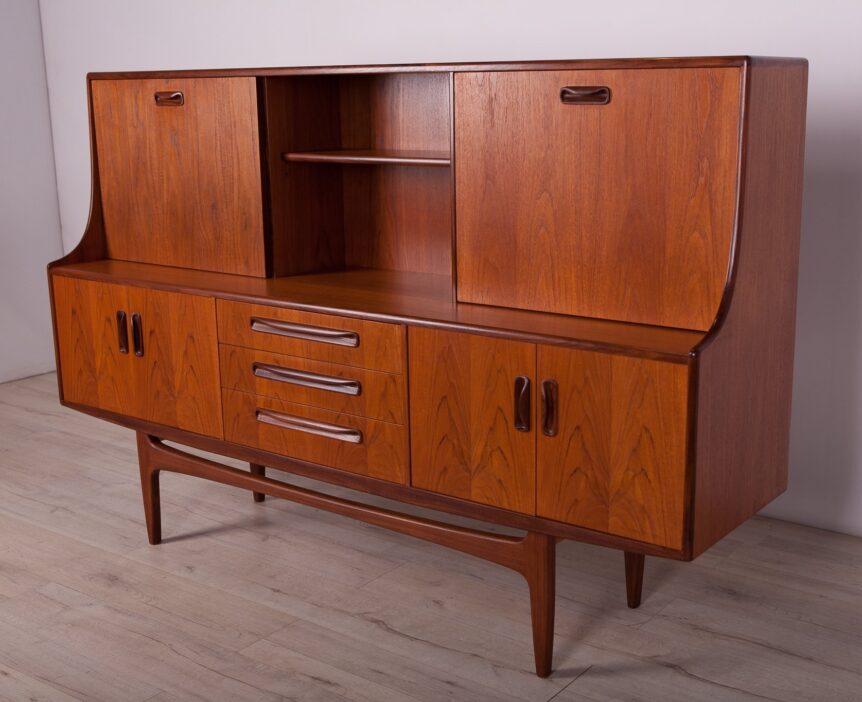See the different ways you can identify a piece of furniture as authentic mid-century modern

Mid-century modern furniture has been slowly growing in popularity over the last decade and is now one of the most sought after items for adding a touch of class to contemporary homes.
And you can see why – it was built to last by manufacturers who placed an emphasis on quality craftsmanship and was designed with both aesthetics and functionality in mind.
However, because of the popularity of mid-century furniture contemporary manufacturers are making new items in this design, making it harder to identify authentic mid-century pieces.
So how can you tell if a piece of furniture is mid-century modern?
There are a few things you can do to Identify mid-century modern furniture which includes, looking for a manufacturer’s name or stamp, considering its functionality and looking for design features such as minimal clean geometric lines. Other ways to identify include finding out the type of wood it was made from and the construction techniques used.
I will go into more detail on how to examine these elements to determine if a piece is in fact authentic mid-century modern furniture and not a modern replica.
Contents:
- What years are considered mid-century furniture?
- Brand name & stamps
- Functionality
- Design
- Colours
- Build materials
- Construction
- Key takeaways
1. What years are considered mid-century furniture?
The mid-century modern movement in general, which not only focused on furniture design but more broadly on a wide range of designs such as interiors, architecture, materials and technology became popular just after world war two and is generally accepted to have lasted between 1945 and 1960.
2. Brand names & stamps
An effective way to tell if a piece of furniture is mid-century modern is to look for a manufactures stamp or brand name.
Some of the best items produced in the era between 1945 and 1960 were made by well-known manufacturers of their time and known for their craftsmanship and for creating pieces that were functional, stylish and made to a high quality.
Some brands to look out for to identify MCM furniture include:
Ercol – Established over 100 years ago and still going strong today, Ercol created some beautiful pieces of mid-century furniture that included dining tables and chairs, coffee tables and sideboards. Furniture made by Ercol in this period is probably one of the most expensive today, especially pieces in its “blonde” collection of the 1960s.
G-Plan – Another brand that can help identify mid-century furniture is G-plan. They became famous in the 1960s for their Danish-inspired furniture based on minimalism, clean lines and a modern design. Some highly sought after items of furniture created by G-plan today include Fresco sidebars, chest of drawers and Astro coffee tables.
Nathan – Nathan furniture was founded in 1916 and was well known for its craftsmanship in the mid-century modern period. In particle, they are known for making stylish furniture between the 1950s and ’60s and again based their designs on the popularity of Scandinavian style furniture.
Some other brands to look to identify mid-century modern furniture include:
- Macintosh
- Stag
- Jentique
- Schrieber
- Stonehill
- Lebus
- Parker Knoll
- Broyhill
- Ray & Charles Eames (Vitra)
Related articles:
- How To Value Mid Century Modern Furniture
- 5 Reasons Why Vintage Is So Popular
- 9 Best Vintage Furniture Brands
- 20 Best Mid-Century Modern Furniture Brands
3. Functionality
Another way to identify mid-century modern is to consider the purpose it was made for and its functionality in the home environment.
Habits and living styles were different in the time mid-century furniture was being produced which meant there were items of furniture made in that era that would not be very functional and therefore not produced today.
This is because homes are smaller on average which means less space for large items of furniture and technological changes.
In particular items such as cocktail bars, vinyl cabinets, large room divers and cabinets can be a tell-tale sign that these were produced in another era. Similar items such as writing bureaus were popular in their day as a desk and keeping stationary in a time before home pcs and computer desks.
However, this is not to say these items are now defunct – in fact, furniture such as writing bureaus are regaining popularity due to their aesthetic appeal and are being used as desks for their laptops.
4. Design
Mid-century modern furniture was born out of the modernist movement and was adopted by a host of Scandinavian designers and is characterised by its minimal and simple design, clean lines, geometric shapes, functionality and quality construction. This design revolution was quickly adopted by a host of other furniture manufacturers in the US and UK.
Another characteristic that defines mid-century modern design is pieces that were created to stand off the floor on for slender wooden or metal hairpin legs.
Here are a few images to give you an idea:


However, it’s worth noting there has been a renewed popularity of mid-century furniture, which means contemporary manufacturers are producing new pieces of furniture today (often known as retro) based on the Scandinavian designs of the 1950s. and 60s This can sometimes make it harder to identify mid-century furniture made in that era.
Here is a newly constructed Jenson sideboard for example available to purchase on Made.com. You can see it has similar design features as the Macintosh sideboard that was made in the 1960s.

Related articles:
- Why Is Mid-Century Furniture So Expensive?
- How To Find Cheap Mid-Century Furniture
- 15 Best Vintage American Furniture Brands
- 17 Best British Furniture Manufacturers From The1950s, 60s & 70’s
- How to Identify Georgian Furniture (1714-1830)
5. Colours
Mid-century modern furniture designers also placed emphasis on colour when it came to designing furniture in this era. The Pre-war years were all about rationing and focused mainly on a narrow range of colours, many green and brown. This all changed in the post-war years when populations began to boom and so did people’s expectations and pay packets.
Combinations of natural light brown teak wooden furniture, such as sideboards and coffee tables were mixed with bold colour fabrics for making items like sofas and armchairs (think limes greens, orange and deep reds).

Photo by – More living room photos
6. Build materials
Another way to can tell if a piece of furniture is mid-century modern is by the type of material it was constructed with. Furniture manufacturers in this period produced most of their furniture using mainly hardwoods, notably teak and other types such as Rosewood, elm and beech to make solid wood furniture.
To drive down costs they also produced furniture using wood veneer which is a process of laying a thin layer of expensive wood such as teak over cheaper cuts like MDF.
They also used laminate (also known as Formica laminate) which is a technique of laying thin pieces of synthetic material (usually plastics) made to look like wood over MDF. They even experimented with materials such as acrylic.
Here is a useful in-depth guide I found that can help you identify what type of wood an item of furniture is made from – whether it’s a solid wood construction or is made using sheets of a veneer and laminate.
Related articles:
- 10 Best Vintage Danish Furniture Brands of the 1960s and 1970s
- How To Identify Broyhill Furniture
- What Wood is Used for Mid-Century Modern Furniture?
- How To Identify A Vintage Or Antique Desk
7. Construction techniques
Construction techniques are useful when identifying mid-century furniture, especially items that are used for storage which include sideboards, high boards and chest of drawers
The drawers on these items were often constructed by using a joinery technique known as “Dovetail joints”. This is a process of fixing two pieces of wood together through wood joints without the need for glue or nails and was a popular method of making drawers, particularly in mid-century modern furniture construction.
Items of mid-century furniture that were made using this technique are also a tell-tale sign that the piece of furniture is made from solid wood and hence is likely to be more expensive than veneer or laminate furniture and has been built to a high quality.

Related articles:
- What is the best oil to use on teak furniture?
- How to Spot Handmade Furniture: Identifying Quality Craftsmanship
- How To Identify West German Pottery
- How To Identify A Mid-Century Lamp
- How to Identify Authentic Charles Eames Chairs
8. Key Takeaways
Due to its popularity, mid-century modern furniture is now being replicated by contemporary furniture manufacturers based on design features of the 1950s and 60s. This means identifying authentic mid-century furniture can sometimes be tricky when you are relying on design features alone.
The most effective way to identify MCM is to look for a manufacturer’s name or stamp as most producers of furniture in this era are no longer trading (G-Plan and Nathan are prime examples). Other ways to determine mid-century furniture include the types of material and construction techniques used to build the furniture.


